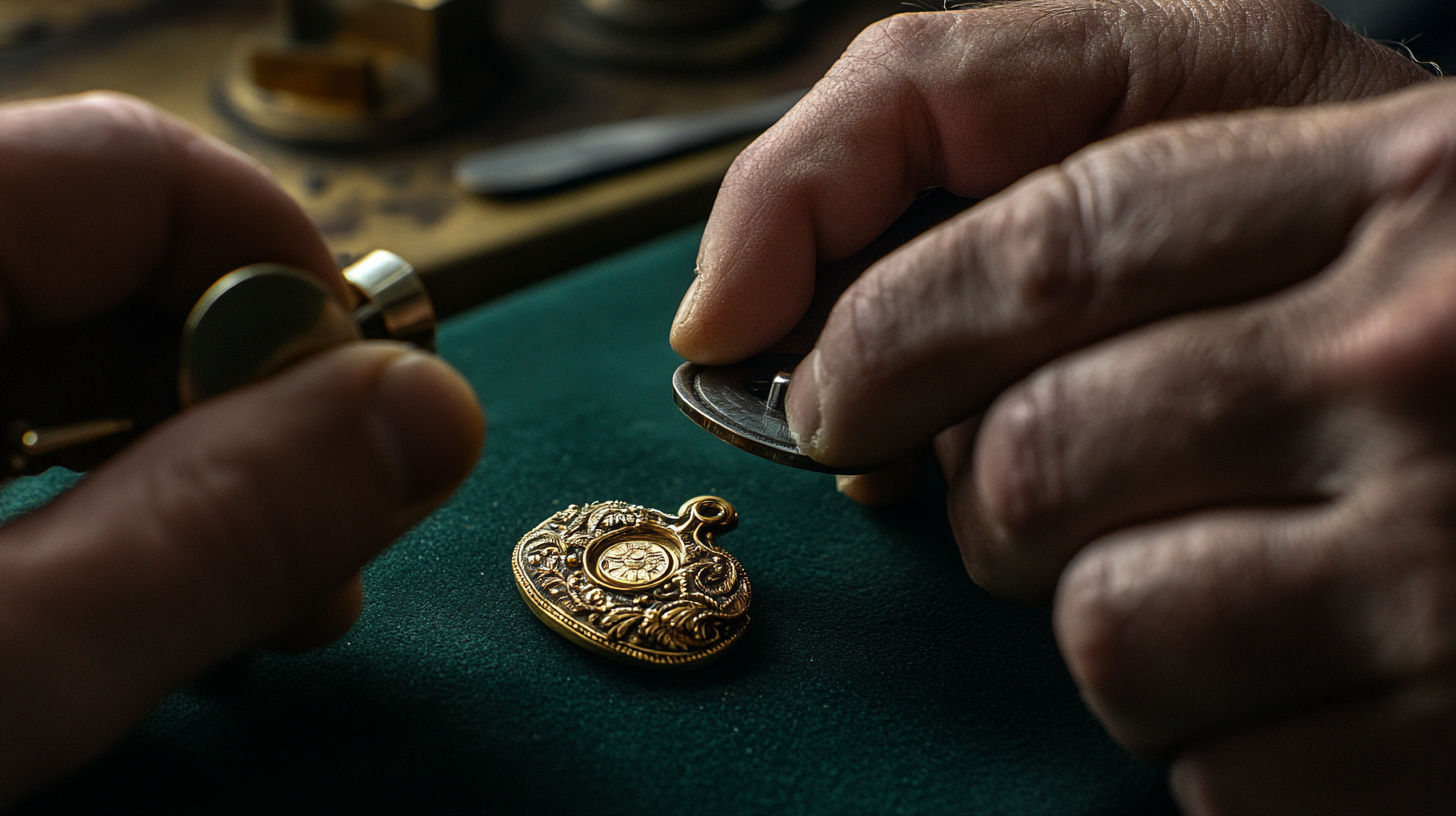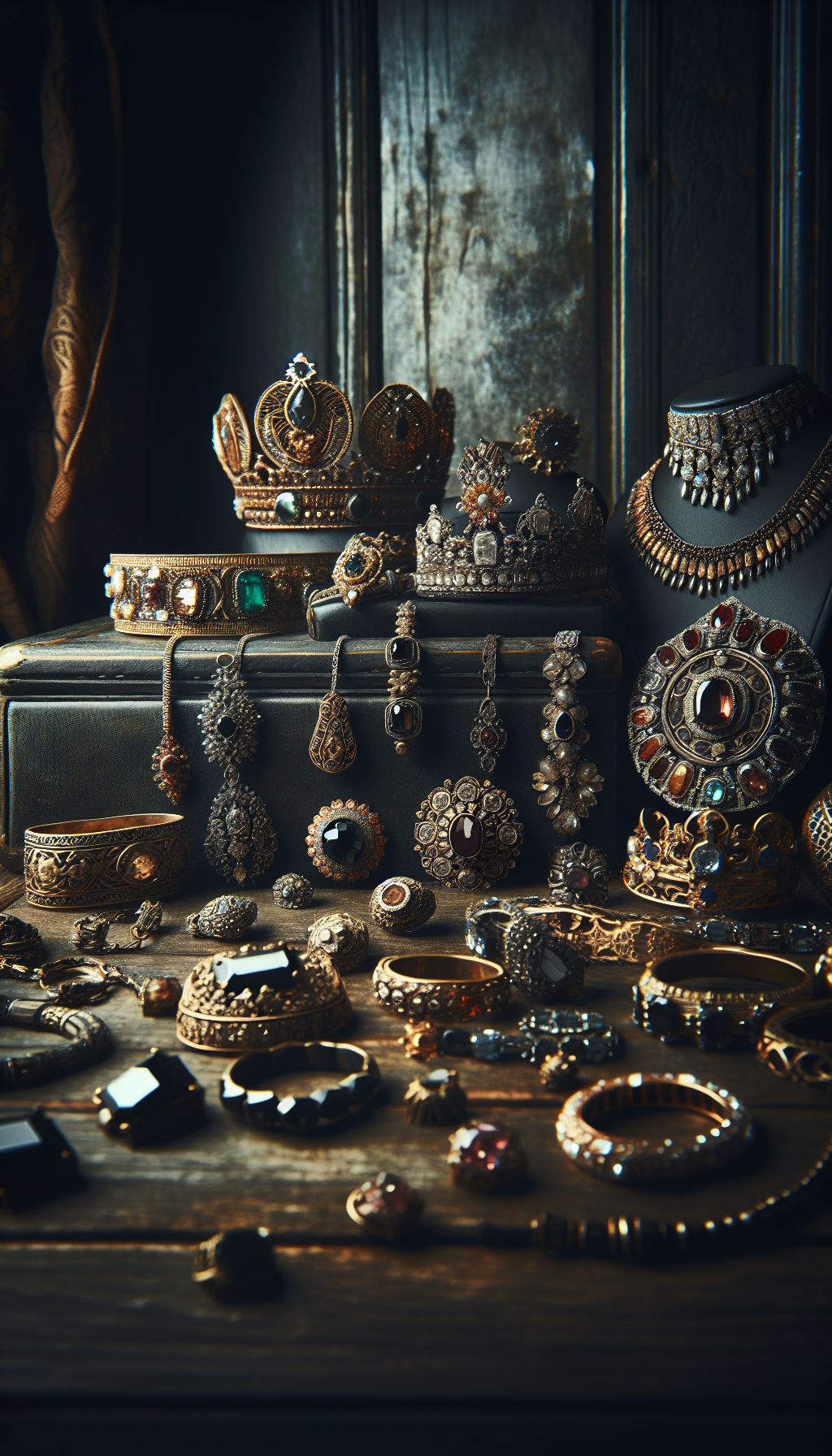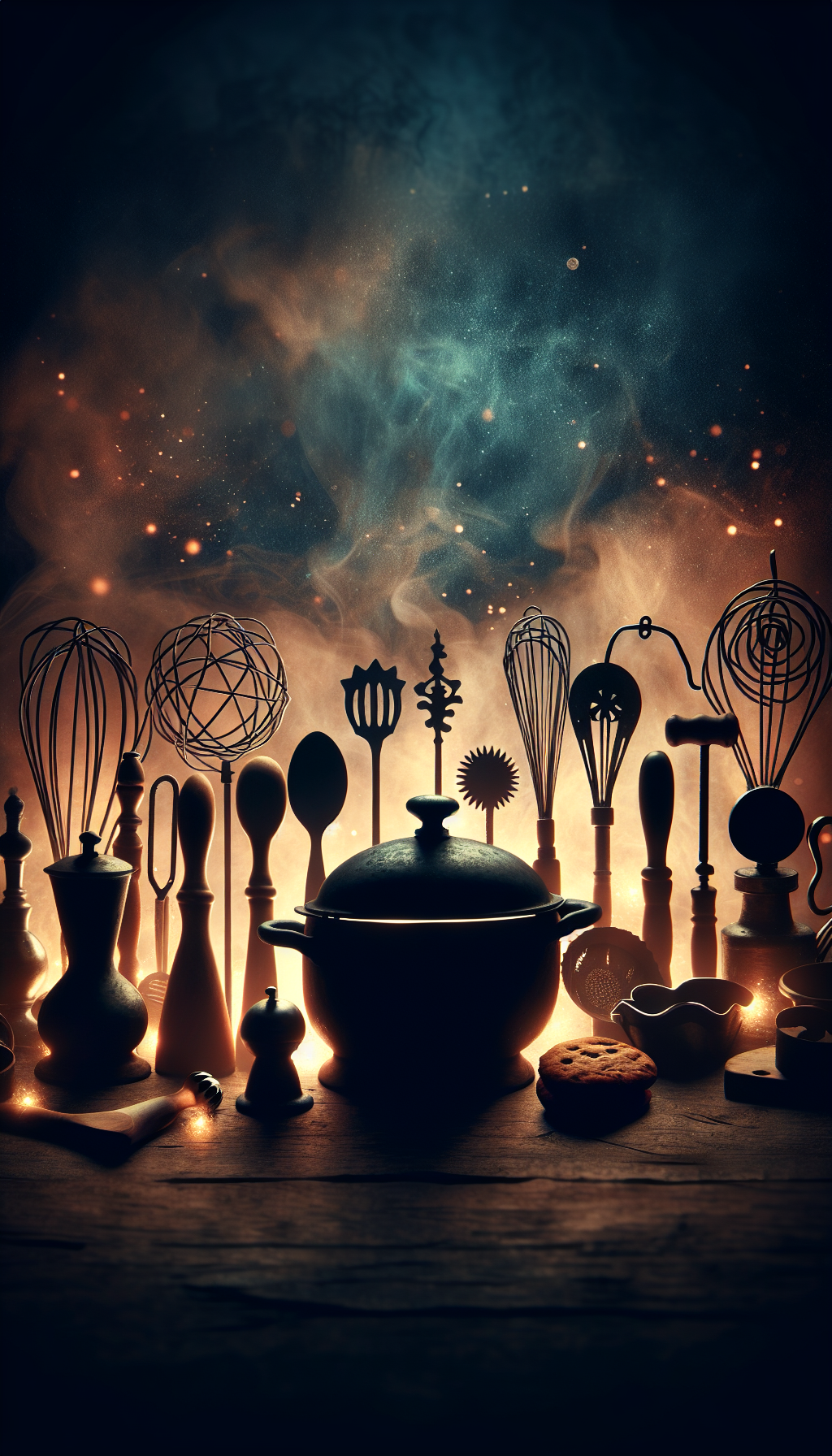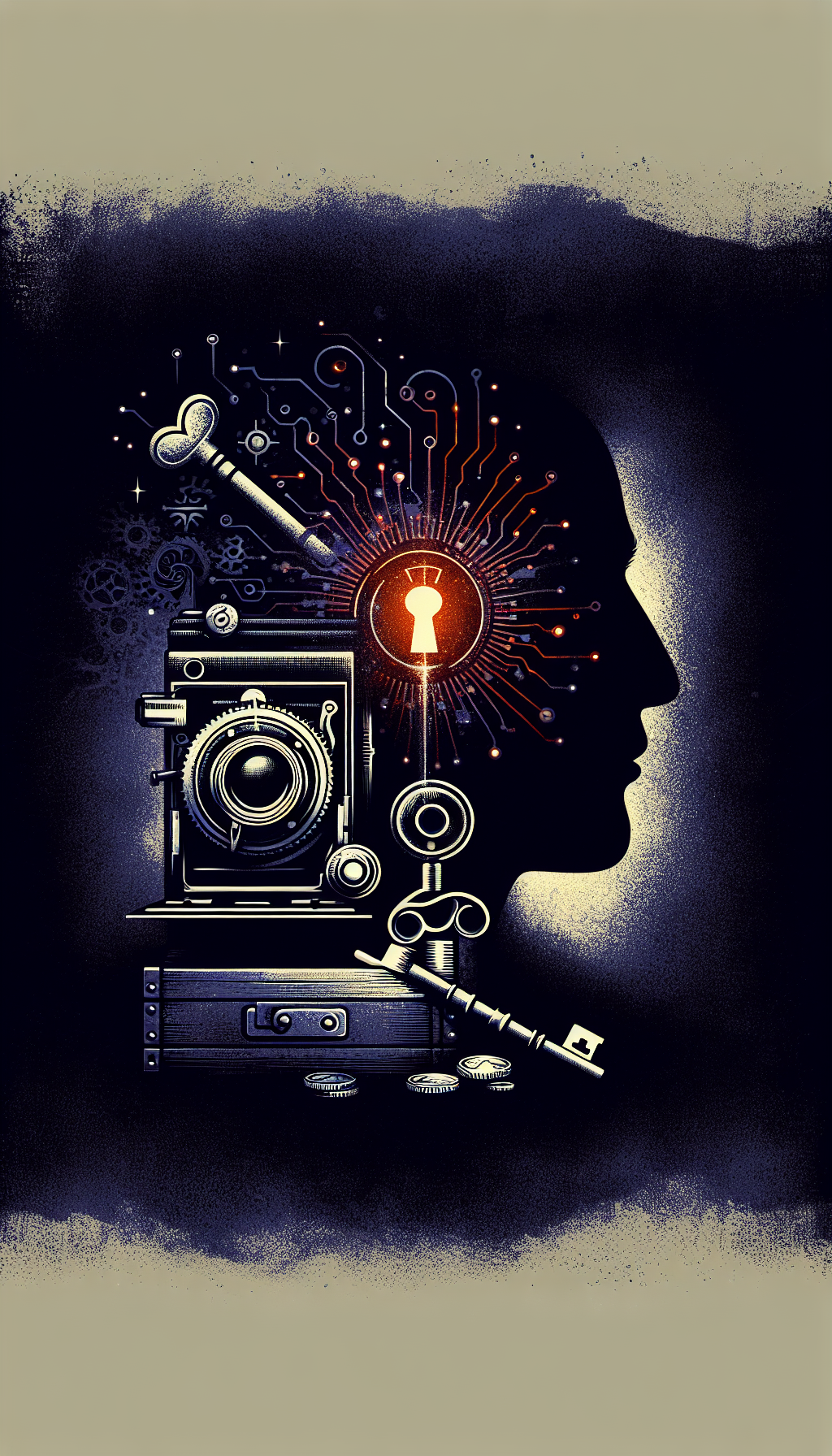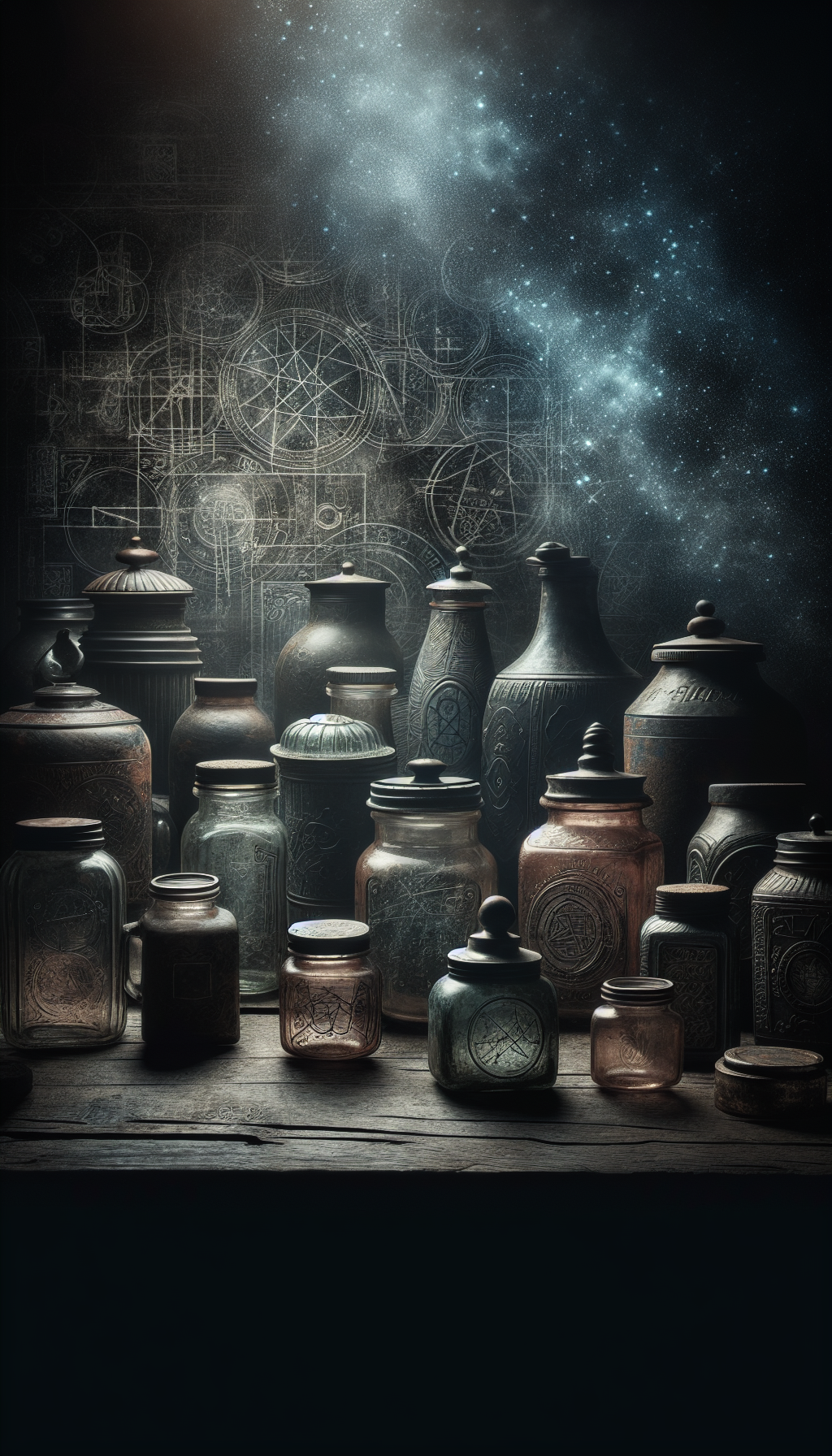Cufflinks might be small in size, but they can hold tremendous value to collectors and enthusiasts. From humble brass pairs worth $20 to platinum and diamond masterpieces fetching thousands at auction, these functional fashion accessories have become prized collectibles with a thriving market.
Whether you’ve inherited vintage cufflinks or are building a collection, understanding their value requires knowledge of materials, craftsmanship, history, and provenance. This comprehensive guide will walk you through everything you need to know about determining the value of old cufflinks.
Table of Contents
- What Makes Old Cufflinks Valuable?
- How to Identify Vintage Cufflinks
- Determining Age and Authenticity
- Value by Material and Design
- Famous Makers and Their Value
- Current Market Prices
- Where to Buy and Sell Vintage Cufflinks
- Caring for Your Cufflink Collection
- FAQ: Common Questions About Old Cufflinks Value
What Makes Old Cufflinks Valuable?
Unlike regular clothing accessories, vintage cufflinks can be worth significant sums due to their unique combination of artistry, materials, and historical context. The following factors most heavily influence their value:
Material Composition
The materials used in cufflinks significantly impact their worth. The most valuable cufflinks typically contain:
- Precious Metals: Gold (especially 18K and 22K), platinum, and high-quality sterling silver command premium prices.
- Gemstones: Diamond, sapphire, ruby, and emerald-set cufflinks are particularly sought after.
- Rare Materials: Pieces featuring unusual materials like rare hardstones, meteorite, or ancient coins can fetch higher prices.
Craftsmanship and Design
Exceptional craftsmanship dramatically increases value, particularly:
- Handcrafted Details: Hand-engraving, filigree work, and other meticulous techniques
- Enamel Work: Guilloche enamel, plique-à-jour, or cloisonné techniques
- Unique Mechanisms: Innovative or complex closure mechanisms
- Designer Aesthetics: Distinctive Art Deco, Art Nouveau, or Mid-Century Modern designs
Historical Period
Cufflinks from certain eras tend to command higher prices:
Value by Historical Period
- 1880-1910
Victorian & Edwardian Era
Known for intricate gold work, seed pearls, and symbolic motifs. High-quality pieces can fetch $500-$3,000. - 1920-1939
Art Deco Period
The most collectible era, featuring bold geometric designs, contrasting materials, and vibrant color. Premium examples range from $300-$5,000+. - 1940-1959
Mid-Century Modern
Characterized by abstract designs, innovative materials, and sculptural forms. Quality pieces typically range from $200-$1,000. - 1960-1979
Modernist & Space Age
Bold, experimental designs using new materials and techniques. Values typically range from $150-$800.
Brand Prestige
Cufflinks from prestigious jewelry houses and designers command significant premiums:
Value Premium for Prestigious Makers
- Cartier: 300-500% premium over comparable non-designer pieces
- Tiffany & Co.: 200-400% premium, especially for vintage blue box pieces
- Van Cleef & Arpels: 300-600% premium for their signature designs
Rarity and Condition
The scarcity of a design and its preservation state dramatically affect value:
- Limited Production: Small production runs or one-of-a-kind custom pieces
- Condition: Minimal wear, original patina, and working mechanisms
- Complete Sets: Matching cufflinks with tie pins or studs in original boxes
How to Identify Vintage Cufflinks
Identifying genuine vintage cufflinks requires careful examination of several key elements:
Construction Methods
Different eras used distinctive construction techniques:
- Chain and Toggle Backs: Common in Victorian and Edwardian pieces (1880s-1910s)
- Fixed Backs: Popular during the late Victorian through Art Deco periods
- Bullet-Back Closures: Widely used from the 1920s onward
- Whale-Back Closures: Became common in the 1930s-1950s
Maker’s Marks and Hallmarks
Authentic vintage cufflinks often feature:
- Precious Metal Markings: Look for gold purity marks (14K, 18K, 750, 585)
- Sterling Silver Hallmarks: “925,” “STERLING,” or country-specific hallmarks
- Maker’s Signatures: Tiffany & Co., Cartier, Georg Jensen, David Andersen
According to the Robert Harris Jewellers guide on antique cufflinks, examining these marks can provide crucial information about a piece’s age and origin.
Materials Analysis
Period-specific materials can help date cufflinks:
- Early Plastics: Bakelite (1920s-1940s), Lucite (1940s-1960s)
- Metal Treatments: Rose gold (popular in Victorian era), white gold (common after 1920s)
- Gemstone Cuts: Old mine cut diamonds (pre-1920s), calibré-cut gems (Art Deco era)
Vintage Cufflink Identification Checklist
Use this checklist to help identify authentic vintage cufflinks
- Examine all metal surfaces for hallmarks and purity stamps
- Check for patina consistent with age (not artificially created)
- Inspect connections and mechanisms for period-appropriate construction
- Look for hand-finishing details typical of the era
- Verify any gemstones have appropriate cutting styles for the period
- Research any maker's marks against known historical manufacturers
Determining Age and Authenticity
Determining the precise age of cufflinks helps establish their value and authenticity:
Dating By Design Elements
Each period has distinctive design characteristics:
- Victorian (1837-1901): Ornate, often featuring naturalistic motifs like flowers, animals, and symbolic emblems
- Edwardian (1901-1910): Lighter, more delicate designs, often using platinum and diamonds
- Art Deco (1920s-1930s): Bold geometric patterns, contrasting materials, and strong color schemes
- Retro Period (1940s): Large scale, three-dimensional designs often in rose or yellow gold
- Mid-Century (1950s-1960s): Clean lines, abstract forms, and modern materials
Authentication Methods
To determine if cufflinks are genuinely vintage:
- Wear Patterns: Authentic vintage pieces show appropriate signs of age and wear
- Material Testing: Gold testing, gemstone verification, and hallmark authentication
- Closure Mechanisms: Examine the style and construction of the closure system
- Comparative Analysis: Compare with known authentic examples from museums or reference books
According to Longmire’s guide to cufflink collecting, “there are plenty of cufflink collectors out there, so bespoke and pieces of quality always remain desirable.”
Common Reproduction Warning Signs
Be cautious of these red flags when evaluating age:
- Modern fastening mechanisms on supposedly antique pieces
- Inconsistent aging or artificial patination
- Incorrect combinations of metals and gemstones for the purported period
- Machine-made details in supposedly hand-crafted antique pieces
Value by Material and Design
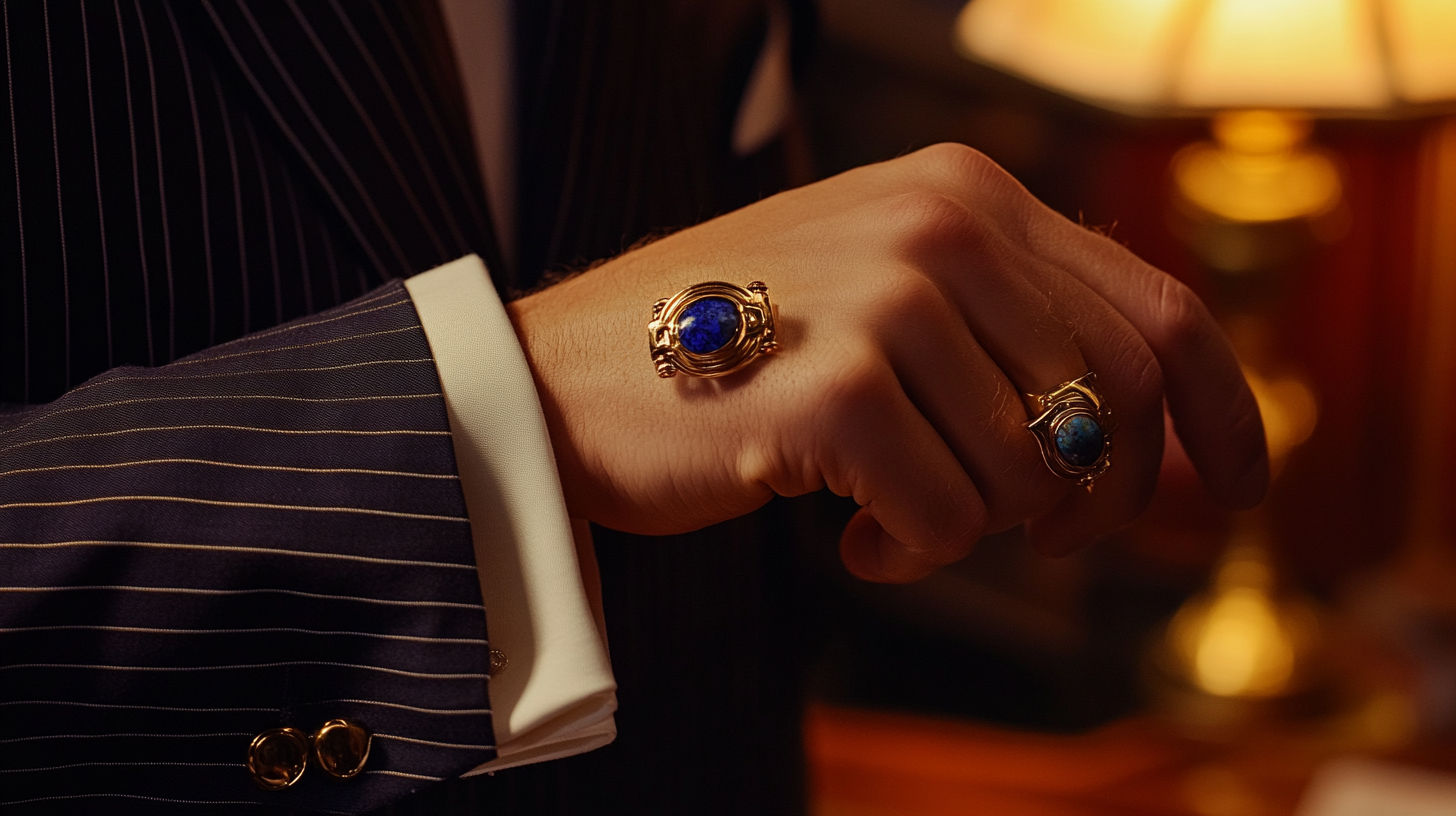
The materials and design styles of cufflinks dramatically influence their value:
Precious Metal Cufflinks
Gold and platinum cufflinks command the highest prices:
Value Ranges by Metal Type
Average market prices for vintage cufflinks by metal composition
</tbody>
</table>
As noted by 1stDibs experts, “Common markings that signify genuine gold include 14K, 18K, 585 and 750.” These hallmarks are essential for authenticating precious metal content.
Gemstone and Inlaid Cufflinks
Cufflinks featuring precious stones carry significant value:
- Diamond-Set Cufflinks: $1,000-$10,000+ depending on carat weight and quality
- Ruby, Sapphire, Emerald: $800-$5,000 for natural stones in precious metal settings
- Semi-Precious Stones: $200-$1,000 for quality examples with lapis, jade, or carnelian
- Mother of Pearl: $150-$600 for vintage examples in silver or gold settings
Design Styles and Their Value
Certain design styles are particularly sought after by collectors:
- Art Deco Geometric: $300-$3,000 for distinctive black and white combinations or colorful enamel work
- Novelty Designs: $200-$1,500 for unusual subjects like cars, animals, or sports themes
- Heraldic/Monogrammed: $150-$800 for personalized pieces with family crests or initials
- Modernist Abstract: $250-$1,200 for bold mid-century designs
According to Market Square Jewelers, designs incorporating jade, hunting motifs, and unique materials like Essex crystal can command premium prices.
Famous Makers and Their Value
Cufflinks from renowned designers and jewelers can command extraordinary premiums:
Luxury Jewelry Houses
The most prestigious names in jewelry consistently produce highly valuable cufflinks:
Notable Designer Cufflink Sales
Recent auction results for prestigious maker cufflinks
| Category | Price | Notes |
|---|---|---|
| 14K Gold | $300 - $1,200 | Depends on weight and design complexity |
| 18K Gold | $500 - $2,500 | Higher premium for designer pieces |
| Platinum | $800 - $3,000+ | Typically Art Deco or mid-century pieces |
| Sterling Silver | $100 - $600 | Higher for enameled or stone-set examples |
| Gold-Filled | $75 - $250 | Value increases with age and condition |
</tbody>
</table>
According to the Antique Jewellery Company, designer provenance can multiply a cufflink’s value several times over compared to similar non-designer pieces.
Notable Specialty Makers
Beyond luxury houses, certain specialist makers are highly collectible:
- Georg Jensen: Danish modernist designs in sterling silver ($400-$1,200)
- Deakin & Francis: British makers known for whimsical, mechanical designs ($300-$2,000)
- Trianon: Contemporary maker of high-end stone-set cufflinks ($500-$3,000)
- David Andersen: Norwegian enameled silver designs ($200-$800)
Limited Editions and Commemorative Sets
Special production cufflinks often carry significant premiums:
- Royal or Presidential Commemoratives: Given as gifts for state occasions
- Corporate Anniversary Editions: Limited production runs for company milestones
- Celebrity-Commissioned Pieces: Custom designs for notable figures
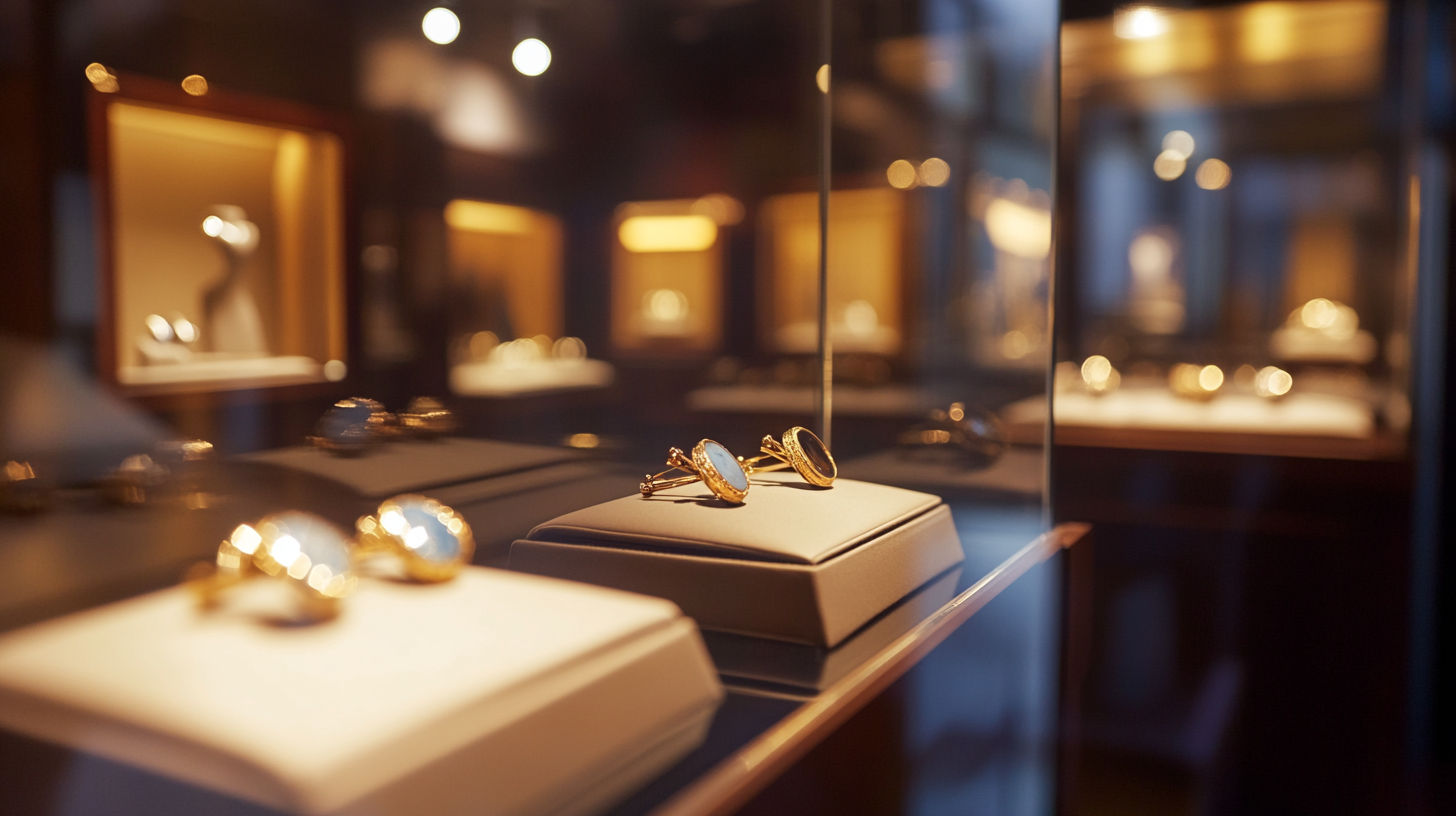
Current Market Prices
The cufflinks market continues to show strong interest from collectors and fashion enthusiasts alike:
Market Trends
According to Market Research Future, “The global Cufflinks Market is expected to grow from 1.95 (USD Billion) in 2025 to 2.5 (USD Billion) by 2034, with a CAGR of around 2.83% during the forecast period.”
This growth demonstrates the enduring appeal of fine cufflinks as both fashion accessories and investment pieces.
Value Categories
The market can be broadly divided into these value categories:
Cufflink Market Segments
- Entry-Level Collectibles: $50-$250 for quality vintage pairs in base metals or silver
- Mid-Range Investment Pieces: $300-$1,000 for gold or designer silver examples
- High-End Collector Items: $1,000-$5,000 for rare designs from prestigious makers
- Museum-Quality Treasures: $5,000+ for historically significant or exceptional examples
Factors Affecting Current Values
Several market factors are currently influencing cufflink values:
- Renewed Interest in Men’s Jewelry: Growing market for men’s accessories
- Social Media Exposure: Instagram and Pinterest driving interest in vintage fashion
- Investment Diversification: Alternative investments including vintage accessories
- Limited Supply: Finite number of quality vintage pieces available
According to dealers at Frank Pollak And Sons, vintage cufflinks represent “an ode to the past—each piece embodying a timeless charm and historical essence” that continues to attract new collectors.
Where to Buy and Sell Vintage Cufflinks
Whether you’re building a collection or looking to sell, knowing the right venues is essential:
Best Places to Purchase Quality Vintage Cufflinks
For buyers seeking authentic vintage pieces:
Specialized Jewelry Dealers:
- The Antique Jewellery Company - Curated selection of premium vintage cufflinks
- Lang Antiques - High-end vintage and designer examples
- DSF Antique Jewelry - Rare collectible pieces
Auction Houses:
- Christie’s and Sotheby’s for high-end designer pieces
- Smaller regional auction houses for mid-range collectibles
Online Marketplaces:
Antique Shows and Estate Sales:
- Often provide opportunities for in-person inspection
- Possibility of finding undervalued pieces
Selling Vintage Cufflinks
For those looking to sell their collections:
Direct to Dealers:
- Typically offers lower prices but immediate payment
- Best for higher-value pieces from recognized makers
Auction Consignment:
- Potential for highest prices but with fees and uncertain outcomes
- Recommended for rare or designer pieces
Online Marketplaces:
- Requires proper identification, valuation, and photography
- Broadest audience but can take time to find the right buyer
Jewelry Shows and Fairs:
- Good for networking with potential buyers and dealers
- Opportunity to gauge market interest in your collection
According to Michelle’s Vintage Jewelry, there’s consistent demand for “Antique and vintage cufflinks from the art deco era through 1980’s” among collectors seeking special occasion accessories.
Caring for Your Cufflink Collection
Maintaining your cufflinks in optimal condition helps preserve their value:
Storage Best Practices
Proper storage is crucial for preserving condition:
- Individual Compartments: Store each pair separately to prevent scratching
- Acid-Free Materials: Use acid-free tissue or soft pouches for each pair
- Climate Control: Maintain moderate temperature and humidity
- Original Packaging: Keep original boxes when possible for added value
Cleaning and Maintenance
Different materials require specific care:
- Gold and Platinum: Gentle cleaning with mild soap and warm water
- Silver: Use proper silver polish for tarnish removal
- Gemstones: Clean with soft brushes and appropriate gemstone cleaners
- Enamel Work: Avoid immersion; clean with slightly damp soft cloth only
Professional Services
Consider professional care for valuable pieces:
- Appraisal Updates: Have valuable pieces reappraised every 3-5 years
- Insurance Documentation: Maintain detailed records with photographs
- Professional Restoration: Seek experienced jewelers for repairs to maintain value
Common Questions About Old Cufflinks Value
Is there a market for old cufflinks?
Yes, there is a strong and growing market for vintage and antique cufflinks. According to Market Research Future data, the global cufflinks market is expected to grow from 1.95 billion USD in 2025 to 2.5 billion USD by 2034, with a compound annual growth rate of approximately 2.83%.
This market encompasses everything from affordable vintage pieces to high-end collector items. Designer cufflinks from prestigious houses like Cartier, Tiffany & Co., and Van Cleef & Arpels are particularly sought after, while unique designs and rare materials also attract dedicated collectors.
Does anyone collect cufflinks?
Yes, cufflink collecting is a well-established hobby with a dedicated following. As noted by Longmire, "There are plenty of cufflink collectors out there, so bespoke and pieces of quality always remain desirable."Collectors often specialize in specific:
- Time periods (Art Deco, Mid-Century Modern)
- Materials (gold, silver, enamel work)
- Designers (Cartier, Tiffany, Georg Jensen)
- Themes (animals, sports, transportation)
- Mechanisms (chain-link, fixed post, novelty functions)
The collecting community includes everyone from fashion enthusiasts to serious investors seeking portfolio diversification through tangible assets.
How can I tell how old my cufflinks are?
You can estimate the age of cufflinks by examining several key characteristics:
Design Style: Victorian cufflinks (1837-1901) feature ornate designs, while Art Deco pieces (1920s-1930s) showcase geometric patterns. Mid-century modern cufflinks (1950s-1960s) typically have cleaner, abstract designs.
Construction Methods: Chain-link backs are common in Victorian and Edwardian pieces, while bullet-back closures became popular from the 1920s onward. Whale-back closures are typically seen in pieces from the 1930s-1950s.
Materials and Techniques: Early plastics like Bakelite indicate 1920s-1940s, while specific gemstone cuts (old mine cut diamonds vs. modern cuts) can help date pieces.
Hallmarks and Signatures: Look for hallmarks, purity stamps (14K, 18K, 925), and maker’s marks that can be researched to determine manufacturing dates.
Patina and Wear: Authentic aging patterns consistent with the purported age, rather than artificial aging.
When in doubt, consult with an experienced appraiser or reference collector’s guides with dated examples.
What is the gold mark on cufflinks?
Gold marks on cufflinks indicate the purity of the gold used and help authenticate the piece. Common gold markings include:
- Karat Marks: "14K" or "18K" indicating 14 or 18 karat gold (58.5% or 75% pure gold respectively)
- European Numerical Marks: "585" (equivalent to 14K) or "750" (equivalent to 18K)
- British Hallmarks: Lion passant plus date letter and assay office mark
- Additional Marks: Maker’s mark or registration numbers
As noted by 1stDibs experts, "Common markings that signify genuine gold include 14K, 18K, 585 and 750." These marks are typically stamped on the back of cufflinks or on the connecting mechanism.
For gold-filled or gold-plated cufflinks, look for marks like "GF" (gold-filled), "1/20 12K GF" (indicating 1/20th of the weight is 12K gold), or "plated" designations.
If you’re uncertain about gold markings, a professional jeweler can perform non-destructive tests to verify authenticity.
What are the most valuable vintage cufflinks?
The most valuable vintage cufflinks typically feature a combination of prestigious makers, rare designs, premium materials, and historical significance:
Luxury House Pieces:
- Cartier Art Deco platinum and diamond sets ($10,000-$25,000)
- Early Tiffany & Co. designs by noted designers like Jean Schlumberger ($5,000-$15,000)
- Van Cleef & Arpels gem-set pieces with signature designs ($3,000-$20,000)
Historical Significance:
- Royal family provenance or presidential gifts
- Pieces owned by celebrities or historical figures
- Commemorative cufflinks from significant events
Exceptional Craftsmanship:
- Complex mechanical or transforming cufflinks
- Intricate micro-mosaic or plique-à-jour enamel work
- Detailed miniature paintings or portraits
Rare Materials Combinations:
- Important gemstones in Art Deco settings
- Unusual materials like meteorite, dinosaur bone, or historic artifacts
- Complex inlay work with multiple precious materials
The auction record for cufflinks has exceeded $400,000 for pieces with exceptional provenance or gemstone content.
Conclusion
The world of vintage and antique cufflinks offers something for every collector and budget. Whether you’re drawn to the geometric brilliance of Art Deco designs, the craftsmanship of luxury house pieces, or the quirky charm of novelty sets, understanding what drives value helps make informed collecting decisions.
As you build or evaluate your collection, remember that condition, authenticity, and provenance play crucial roles in determining value. Take time to research pieces thoroughly, consult experts when needed, and properly care for your treasures to preserve their worth.
With the cufflinks market showing steady growth and renewed interest from fashion enthusiasts and collectors alike, these small accessories continue to offer both aesthetic pleasure and investment potential. Whether worn as elegant finishing touches or preserved as miniature works of art, vintage cufflinks remain enduring symbols of style and craftsmanship.
External Resources for Cufflink Collectors
The Antique Jewellery Company
Curated collection of fine antique and vintage cufflinks with detailed descriptions and authentication.
Lang Antiques Cufflinks Collection
High-end vintage and designer cufflinks with detailed provenance information and historical context.
1stDibs Rare Cufflinks Market
Vetted marketplace featuring premium cufflinks from trusted dealers worldwide.
eBay Antique Cufflinks Category
Wide selection of vintage cufflinks at various price points, requiring careful authentication.
Market Research Future: Cufflinks Market Analysis
Current market data and future projections for the global cufflinks market.
Longmire: Guide to Cufflink Collecting
Comprehensive introduction to collecting vintage cufflinks with expert insights.
DSF Antique Jewelry: Rare Collectible Cufflinks
Specialized collection of museum-quality antique and collectible cufflinks with expert descriptions.
Robert Harris Jewellers: Antique Cufflinks Guide
Practical information on identifying, dating and evaluating vintage cufflinks.
Get a Professional Appraisal
Unsure about your item’s value? Our certified experts provide fast, written appraisals you can trust.
- Expert report with photos and comps
- Fast turnaround
- Fixed, upfront pricing
No obligation. Secure upload.
| Item | Price | Date | Auction House |
|---|---|---|---|
| Van Cleef & Arpels Gold Twist Stirrup Set | $3,250 | 1960s | Lang Antiques |
| Cartier Art Deco Platinum Diamond Dress Set | $12,500 | 1920s | Christie's |
| Tiffany & Co. Gold Knot Cufflinks | $2,800 | 1970s | Sotheby's |
| David Webb Hammered Gold Lion's Head | $4,200 | 1960s | Bonhams |
